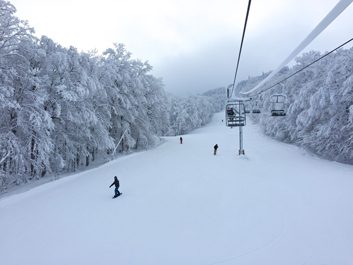Improve your skiing, boost your career?
Writer Kat Tancock shares the life lessons she learned from leaning in on the ski hill

"Use old skills on new terrain, and learn new skills on old terrain," Walt Lattrell, my ski instructor, tells me as we cruise down a gentle warm-up run at Smugglers’ Notch Resort in Vermont.
It’s a lesson that would have come in handy on previous ski trips over the past few years, as I’ve gradually, painstakingly and with a great deal of mental anguish gone from what the ski industry calls a "never-ever" to someone who can reliably, if still cautiously, get down an intermediate run.
And while we’re talking about skiing, it’s a lesson that applies off the hill, too. Improving your skills and getting ahead, in skiing and in life, means pushing past nervousness, leaning in and asserting your confidence ‘ but it doesn’t have to mean recklessness.
"Goethe put it well: ‘Be bold and mighty forces will come to your aid,’" says Greg Dubord, assistant professor in the Department of Psychiatry at the University of Toronto. “Many people interpret their physiological arousal as a sign that there’s danger, but in many cases that’s a misconstrual. Courage can be defined as the willingness to experience physiology while carrying on.”
Step by step gets the job done
It’s been nine months since my last ski day, so Lattrell and I take things slowly as I warm up my legs and revive dormant technique. Vermont’s just had a big dump of snow and while it’s relatively warm out, just a few degrees below zero, we’re skiing through a winter wonderland: the chairlift cables are covered with a thick layer of hoarfrost and the tree branches are silhouettes of white. In other words, it’s eminently Instagram-able out, and the beauty of the surroundings is going a long way toward keeping me motivated.
Lattrell is big on the positive reinforcement, continually telling me how excellently I’m executing various skills, and while I know he’s doing it on purpose as a confidence builder, the truth is, it’s working. A lot of what makes me freeze up while skiing is a variant on imposter syndrome: I’m convinced that my so-called skills are anything but, and that while I might have competently executed the last, oh, 300 turns on the hill, I’ll surely miss the next one and go plunging over the side of a cliff.
Lattrell, in his research on teaching scaredy-cats like me, has found that the key with fearful skiers is often to help them learn to believe in their capabilities, and to bring them step-by-step through increasingly difficult skills and terrain, just enough that they’re challenged, rather than bored ‘ but not so much that the fear returns. Because the irony of learning to ski is that the more you lean back, the harder it is to move with any amount of grace or skill. And so we spend our entire two-hour lesson on day one doing laps on a green run, refining my technique and getting me eager to move on to the blues ‘ "where you belong," he says to me.
It’s the same incremental approach that I bring to big, scary work projects that feel overwhelmingly out of my skill set. While it’s important to recognize when something’s too big to handle, it’s all too common for people to mistake the trees for the forest ‘ to deem something out of their reach when in truth, all the pieces are doable, one by one. Realizing that it’s fear that’s the barrier means committing to trying, confronting anxiety and breaking things down into manageable steps. "Start on the bunny hill, not on Saudan Couloir," says Dubord, referring to a legendary steep run at Whistler-Blackcomb now called Couloir Extreme that I’ll be staying away from for the foreseeable future.
Build confidence here, there and everywhere
On my second day at Smugglers’ Notch, Lattrell and I head up Sterling Mountain, the resort’s paradise for intermediate skiers. We make our way down my first blue of the season (and, to tell the truth, one of my only blues ever) and while I’m nervous at first, especially on the narrower spots, we take breaks to enjoy the views and I’m soon enjoying myself. As the day goes on, Lattrell encourages me to play with new skills, and his enthusiasm translates into confidence, which has me weaving ‘ no falls! ‘ down a couple of slopes so steep, he calls them practically black diamonds. (I’m skeptical, but take the praise.) At the end of our lesson, despite a scary interlude practising skiing on bumps, I’m feeling good and accomplished, excited about the ski season ahead.
The next day, I wake up at Jay Peak, a Vermont resort just a stone’s throw from the Canadian border, and after fortifying with French toast, go to meet Craig Cimmons, director of the snowsports school. It’s warm out and snowing, and quiet on the mountain in the final lull before the Christmas rush. We take the tram to the summit and wait until everyone else has left before we start to meander down the mountain, taking our time to absorb the silence as thick, soft snow coats the trees and the ground.
As I take my last run of the day, I’m struck by two things. First, finally, I feel like I can actually ski, that I can claim this skill as my own, and that if I’m able to achieve this, then there can’t be anything else beyond my grasp. (The official term for this, notes Dubord, is self-efficacy, "the sense that one can complete tasks and reach goals" ‘ something that "can be increased through mastery experiences.") Second, that all the effort and pain was worth it: in the mountains in winter, I feel like I’m home.




